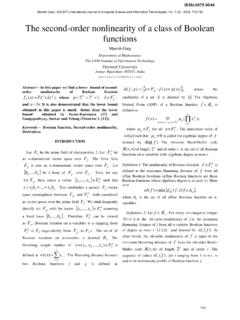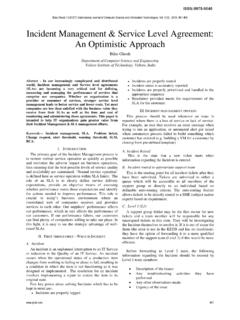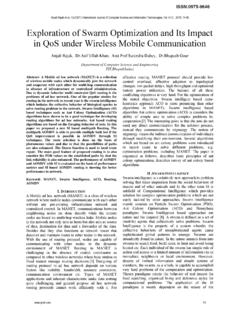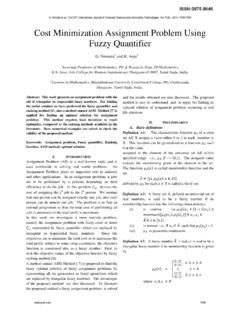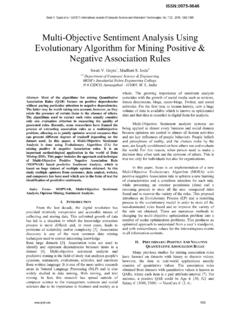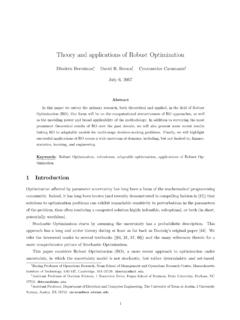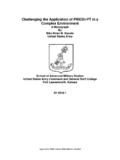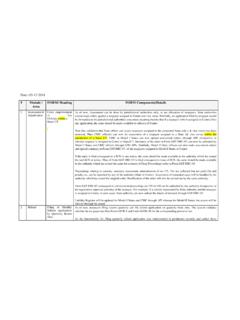Transcription of A Survey on Security Vulnerabilities And Its ...
1 A Survey on Security Vulnerabilities And Its countermeasures At Network Layer In MANET Rishikesh Teke#1, Prof. Manohar Chaudhari*2 #Department of Comp. Sci and Engg, Sinhgad Institute Of Technology Lonavala, Maharashtra India *Asso. Professor, Department of Comp. Sci and Engg, Sinhgad Institute Of Technology Lonavala, Maharashtra India Abstract Mobile ad-hoc network is widely used in today s world as MANET is having characteristics such as wireless connectivity, dynamically changing topology. In MANET mobile nodes also acts as router and interchange the data packets. MANET is used where fixed infrastructure is unavailable or infeasible. Such applications are battlefield communications, crisis management, emergency response operations etc.
2 For these kind of application Security is major issue. In MANET as mobile nodes also routes packet and lack of centralized point they are vulnerable to various routing attacks. In this paper we attempt to Survey on routing attacks such as Blackhole, Wormhole, Grayhole, Packet Drop attack on various routing protocols like AODV and DSR with their countermeasures . Keywords Blackhole Attack; countermeasures ; Grayhole Attack; Mobile Ad-hoc Networks (MANET); Packetdrop Attack; Wormhole Attacks;. I. INTRODUCTION In mobile ad-hoc network (MANET) communication is carried out via multi-hop paths. MANET having collection of autonomous mobile nodes without fixed infrastructure and centralized control point. In MANET due to movement of mobile nodes network topology may change continuously and unpredictably over the time.
3 A typical MANET is as shown in routes in MANET are not stable and this fluctuation in routes varies with respect to time. At the time of connection establishment in MANET mobile node advertise for the route request in the form of routing messages. Existing routing protocols mobile nodes unable to find malicious node in the network thus malicious node take it as advantage and generate fake routing message to advertise non-existing connection links also floods incorrect information. This dynamic nature of MANET make it vulnerable for routing attacks. Most of the routing protocols in MANET are unsecure and are vulnerable for various attacks which makes devastating effects in the network. A lot of research has been done on Security issues in MANET.
4 Most of the attacks done in the routing mechanism of routing protocols. In MANET there are three types of protocols : Routing protocols: These protocols are table driven and select path on the freshness of routes by periodically distributing routing tables throughout the network. Examples of such protocols are Optimized Link State Routing (OSLR) and Destination Sequenced Distance Vector(DSDV). Figure 1. A Typical MANET. Routing Protocols: These kind of protocols finds path on demand by flooding with Route Request packets. Examples of Reactive Routing Protocols are Ad-hoc On Demand Distance Vector Routing(AODV) and Dynamic Source Routing(DSR). Routing Protocols: These kind of protocol is combines advantages of proactive and reactive routing protocol.
5 Initially routing is done using proactively mechanism and then serves demand from additionally activated nodes through reactive flooding. Zone Routing Protocol(ZRP) is an Example of Hybrid protocol. II. TYPES OF ATTACK IN MANET A. Active Attacks Attacks in which malicious nodes actively participate and disrupt the network operation are called Active attacks. In active attacks malicious nodes alter the information or provide fake information in the network. Active attacks can be Internal or External. External attacks done by node that do not belong to the network where internal attacks done by malicious node which belongs to the network. Spoofing, Denial of Service(DoS), spoofing, modification, impersonation are types of active attacks.
6 Rishikesh Teke et al, / (IJCSIT) International Journal of Computer Science and Information Technologies, Vol. 5 (6) , 2014, Passive Attacks Attacks which does not disrupt the normal operation of the network is called Passive attacks. Passive attacks are hard to detect as they never harms the operations of network. Confidentiality of information is violated in this kind of attacks. Passive attacks are traffic analysis, eavesdropping and monitoring. III. Security Vulnerabilities AT NETWORK LAYER In MANET all routing protocols depends upon active co-operating nodes which provide routing between mobile nodes to establish and setup the network. Ad-hoc On Demand Distance Vector(AODV)[5] and Dynamic Source Routing(DSR)[6] are two widely used protocols in MANET.
7 These protocol won t have inbuilt routing Security and thus several attacks can be mounted on these protocols. Protocol uses Route Request messages and Route Reply messages to setup connection between source and destination. Also mobile nodes maintains their routing table in cache for further communication. Routing messages and routing tables in cache are main weaknesses of routing protocol on which malicious node can attack and disrupt the network. Following are the major routing attacks in MANET 1. Black Hole Attack : In two phases blackhole is done. First phase, malicious node attacks on routing protocol such as AODV and exploits its routing mechanism such that if source broadcasts its route request blackhole responds that request sending route reply packet and advertise itself having valid route to destination.
8 The routing mechanism selects path to destination via malicious node. In second phase malicious node gets incoming packets and discards without forwarding them.[8] 2. Wormhole Attack Wormhole attack is replay attack on routing control plane. Without increasing hope count value, attacker node tunnels request packets to destination.[9] Attacker node records packets at one location and replay them at another location this tunneling can be wired or wireless communication. Attacker node manipulate nodes and that nodes sends their traffic through attacker node. Thus attacker node can have aggregate traffic of nodes and can modify , record or even drops the packet.[7] 3. Grayhole Attack Grayhole is variants of Blackhole attack where malicious nodes interchanges their states from black hole to honest intermittently and vice versa.
9 [2][11] Grayhole nodes partially drops packets due to malicious nature and congestion in network. Due to such interchanging behaviour grayhole is difficult to detect and prevent[12]. 4 Packet Drop Attack Packet Drop is kind of Denial of Service(DoS), in which malicious node drops packets passing or routing through it. Instead of attracting neighboring nodes traffic Packet dropping node only drops packets and also Blackhole attack completely degrade performance but Packet Drop attack degrade it partially so it is different from Blackhole attack.[4] There are various for dropping packets like energy consumption or packet sniffing purpose. IV. RELATED WORK Security countermeasures are broadly classified into two areas one is prevention techniques and another is detection techniques.
10 We did extensive Survey of major attacks and their countermeasures from following research papers. Jian-Ming Chang at el [3] propose a scheme called Cooperative Bait Detection Scheme(CBDS) for detecting and preventing grayhole and blackhole attack in MANET. CBDS is uses DSR[6] as underlying routing protocol. In this approach source node takes help from trusted neighbouring node and sends its address as destination address to other nodes. After sending RREQ message in the network, if there is malicious node then it sends RREP message to source node having valid route to given destination address and other trusted neighbouring node will not send RREP message. Malicious node detected and prevented using reverse tracing technique.

